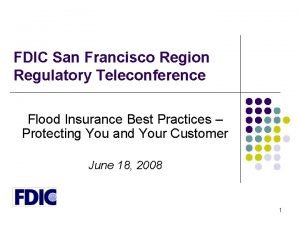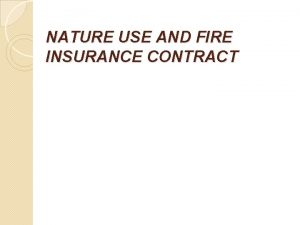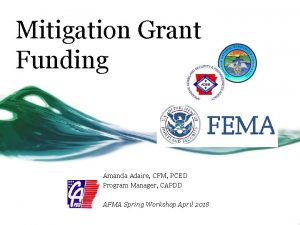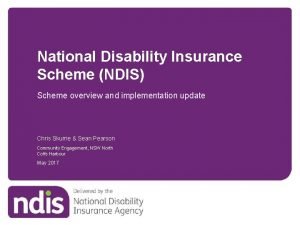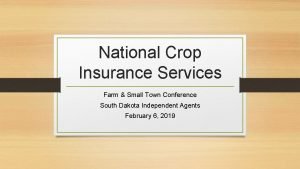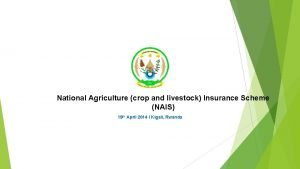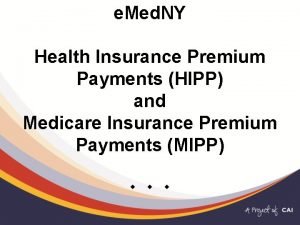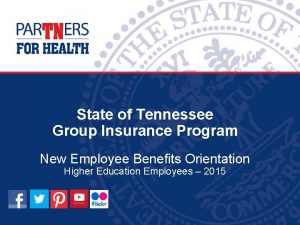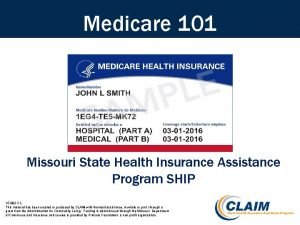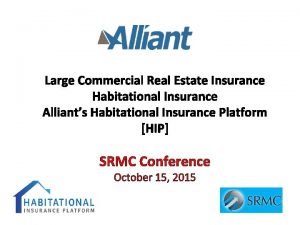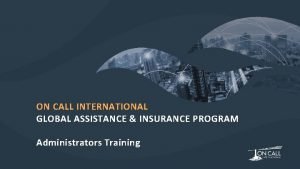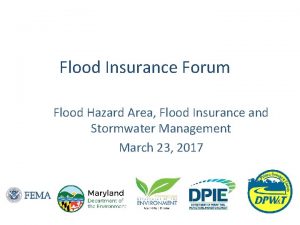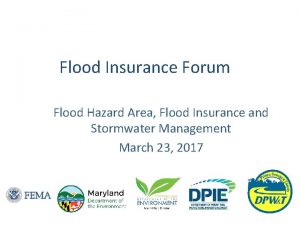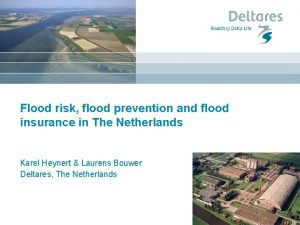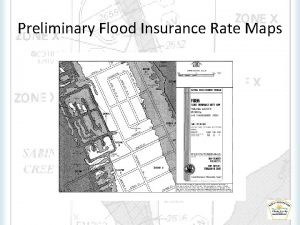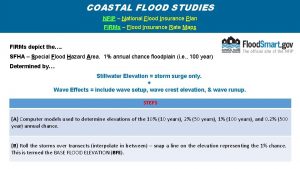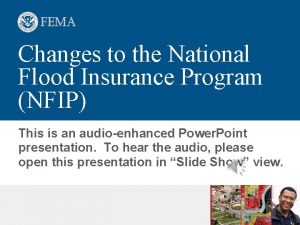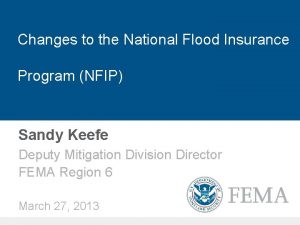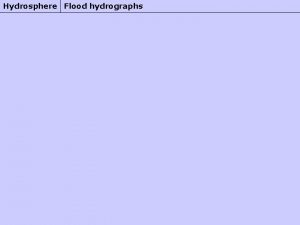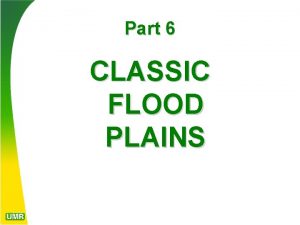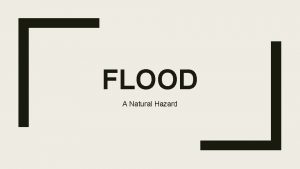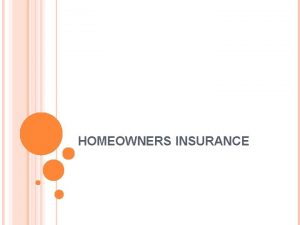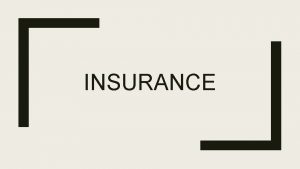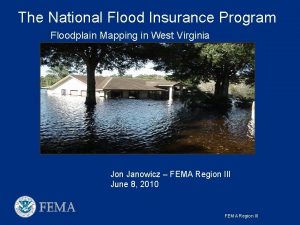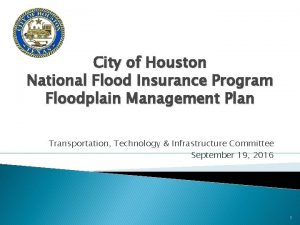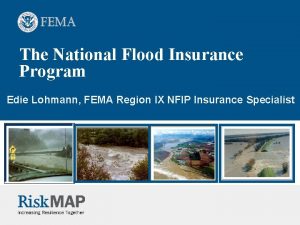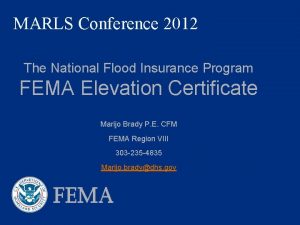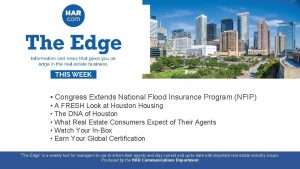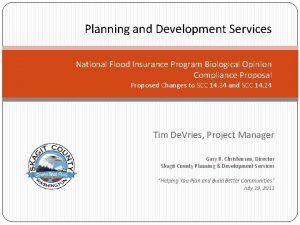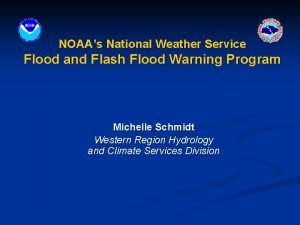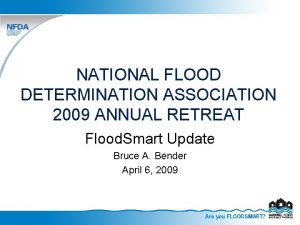Changes to the National Flood Insurance Program What

































- Slides: 33

Changes to the National Flood Insurance Program – What to Expect Impact of changes to the NFIP under the Biggert-Waters Flood Insurance and Reform Act 0 f 2012 (BW-12) and the Homeowners Flood Insurance Affordability Act of 2014 (HFIAA)

Why the Changes to the NFIP Insurance Program? § 1968: Congress created the NFIP to make affordable flood insurance generally available. • • To participate, communities adopt and enforce floodplain management measures for all new development. For structures built before FEMA mapped the Special Flood Hazard Area (called Pre-FIRM properties), the NFIP made flood insurance available at subsidized rates. § 45 years later: The costs and consequences of flooding are increasing and artificially low rates and discounts no longer are sustainable. § In 2012, Congress passed legislation (BW-12) to make the program more sustainable and financially sound over the long term. § In 2014, Congress passed legislation (HFIAA) to reform some sections of BW-12 2

Changes to NFIP Insurance BW-12 and HFIAA • • Establish a Reserve Fund (5% for most policies) Annual premium adjustment cap raised from 10% to 20% (18% HFIAA) Implementation Pending (HFIAA) • Surcharge on all policies to offset the subsidized policies and achieve the financial sustainability goals of BW-12. $25 annually on Primary Residence • $250 annually on All other policies, including full risk rated policies § This fee will continue until all Pre-FIRM subsidies are eliminated § Surcharges are not considered part of the premium and are not subject to the premium increase caps • All policyholders will receive a premium increase 3

NFIP Rate Changes Pre-FIRM Primary Residence (definition changing June 2014*) rates will increase up to 18% Pre-FIRM Non-Primary Residence January 2013 rates will increase 25 % annually until they reflect the full-risk rate. Pre-FIRM Business & Repetitive Loss/Severe Repetitive Loss properties October 2013 rates will increase 25 % annually until they reflect the full-risk rate. All other rating groups will increase up to 18% annually Annual rate increases include the 5% Reserve Fund fee *Primary Residence. For rating purposes only, FEMA defines a primary residence as a building that will be lived in by an insured or an insured’s spouse for more than 50% of the 365 days following the policy effective date. (June 2014) 4

Homeowner Flood Insurance Affordability Act 2014 (HFIAA) § Implementation Pending Effective on or after May 1, 2014 Pre-FIRM rates may be used. New policies will be issued with Pre-FIRM rates. Renewals will be re-rated with Pre-FIRM rates (October 2013 Flood Insurance Manual). Applicable refunds will be implemented at a later date. • Refunds § Guidance and rate tables being developed. § Refunds only to policyholders who received rate increases under BW-12 that are revoked by HFIAA. 5

Adoption of a new flood map? Implementation Pending New SFHA / Zone Change / Increased BFE • BW-12 Removed Grandfathering*/ HFIAA restored grandfathering • BW-12 Elimination of PRP Eligibility Extension / HFIAA - Eligible for PRP first year • 18% cap on annual increase after a map update *Grandfathering-- charging of insurance premiums for a structure based on a prior FIRM • Continuous Coverage • Built in Compliance 6

Affordability Study / Framework § The affordability study required by BW-12 is underway and being conducted by the National Academies of Sciences as specified in BW -12. § HFIAA requires FEMA to prepare a draft affordability framework, which is due to Congress 18 months after completion of the affordability study. § The affordability framework will include proposals and proposed regulations for ensuing flood insurance affordability among lowincome populations. 7

Mapping Enhanced Communication and Outreach § FEMA will continue Mapping activities § BW-12 requires FEMA to enhance coordination with communities before and during mapping activities and requires FEMA to report certain information to members of Congress for each State and congressional district affected by preliminary maps. § Sec. 30 of HFIAA requires additional layers of enhanced notification and outreach to congress and other stakeholders. Technical Mapping Advisory Council § Technical Mapping Advisory Council (TMAC) to review the new national flood mapping program activities authorized under the 2012 and 2014 flood insurance reform laws. • FEMA will seek the TMAC’s recommendations on meeting new requirements for the new mapping program including the identification of residual risk areas, coastal flooding information, land subsidence, erosion, expected changes in flood hazards with time, and others. • The law requires the Administrator to certify in writing to Congress that FEMA is utilizing “technically credible” data and mapping approaches. 8

Mapping Flood Insurance Rate Map Appeals § The Act lifts the $250, 000 limit on the amount FEMA can spend to implement a program to reimburse property owners and communities for successful map appeals based on a scientific or technical error. § The Act applies to statutory appellants who successfully appeal the Agency’s proposed flood elevations and special flood hazard areas. § Rulemaking is required to implement this provision § The new law does not apply to Letter of Map Amendment (LOMA) and Letter of Map Revision (LOMR) requests, or any expenses associated with them. 9

Mapping Flood Protection Systems § Authorizes FEMA to account for state and local funds used in the construction or restoration of a flood protection project when determining whether the project meets the statutory requirements to be eligible for discounted premiums. (Sec. 19) § Permits FEMA to include the value of existing protection features in measuring adequate progress for the restoration of levees. (Sec. 19) 10

Mapping Fees • Law exempts mapping fees for flood map changes due to habitat restoration projects, dam removal, culvert re-design or installation, or the installation of fish passages. (Sec. 22) Flood Control Features • Law requires FEMA to consider the effects of non-structural flood control features, such as dunes, and beach and wetland restoration when it maps the special flood hazard area. (Sec. 27) 11

Moving Forward FEMA Region 10 Mitigation Program areas will advise our stakeholders as HQ guidance and implementation of BW-12 and HFIAA are released. 12

LEVEES: OVERVIEW ON CHANGES TO POLICIES Objectives: • FEMA’s roles • Ongoing levee projects by state • Updates pertaining to Biggert-Waters (2012) and HFIAA (2014) • Non-accredited levee analysis and mapping approach and guidance (2011 -Present) • Region X Perspective David Ratté, P. E. FEMA Region X Mitigation Division Risk Analysis Branch

FEMA’s Role - Levees Map levee-related flood risk and “accredits” levees for mapping purposes only. Accredit levees based on the certification documentation provided by the community or another interested party. FEMA does not own, operate, maintain, inspect, or certify levees or flood control systems. Produce and/or distribute outreach and communication materials. 14

ALASKA 2 -3 Studies 15

IDAHO 8 Studies 16

OREGON 11 Studies 17

WASHINGTON 14 Studies 18

Biggert-Waters and Homeowner Flood Insurance Affordability Acts - Residual and graduated risks for areas associated with potential levee and dam failures - Levee restoration/improvement projects - Federal funding no longer required - Changes “adequate progress” requirements 19

Shaded Zone X or Zone B - Leveed Area (also sometimes referenced as the protected area) NLD and FIRM images… 20

How to acquire a restoration designation? § Requirements per CFR • Community must apply for use of this zone designation • Prior to new legislation, AR designation required that the levee was constructed with Federal funds (regulations not updated at this time) shown as providing protection, and “decertified” • Requesting community must document adequate progress • New legislation extends application of this process to coastal levees 21

Zone AR and A 99 § AR Flood Zone – used to map the landward side of a levee undergoing restoration – usually done before a levee qualifies for A 99 § A 99 Flood Zone – used to map the landward side of a levee that is making “adequate progress” towards being restored. § Enables a community to avoid de-accreditation of a previously certified levee while it is being restored. § Usually has lower insurance rates and less rigorous floodplain management requirements 22

More Information: Fact Sheets and Frequently Asked Questions § Zone AR (Flood Protection Restoration) • Requirements Summary for State and Local Officials • Frequently Asked Questions Regarding the Zone AR Flood Insurance Risk Zone Designation § Zone A 99 (Adequate Progress on Flood Protection Systems) • Zone A 99 Requirements Summary for State and Local Officials • Frequently Asked Questions Regarding the Zone A 99 Designation 23

Analysis and Mapping of Non. Accredited Levees 24

FEMA Levee Status: Accredited vs. Non-Accredited § Accreditation – FEMA’s process to review and accept certification data and documentation and to update the Flood Insurance Study § To be accredited by FEMA, a levee must meet ALL Section 65. 10 requirements, including • General Requirements— 65. 10(a) • Design Criteria— 65. 10(b) • Operation Plans and Criteria— 65. 10(c) • Maintenance Plans and Criteria— 65. 10(d) • Certification Requirements— 65. 10(e) § Non-accredited levee – any levee that does not meet certification requirements or the definition of a levee. 25

Non-Levee Embankment • any manmade topographic feature that does not meet the definition of a levee, e. g. highway embankment (FHWA Policy) or railroad grade Silvies Levee (http: //www. flickr. com/photos/oregondot/5600666113/in/set 72157626331012873) 26

Old Method - Mapping Flood Hazards § Complete certification of § Certification submittal not system submitted to FEMA § Mapped as contained within levee system boundaries received or incomplete § Traditionally mapped as if the levee did not provide a reduction in flood risk 27

What’s New? § Interactive stakeholder engagement throughout the analysis and mapping process: • FEMA will engage community officials and decision makers in a collaborative discussion § A suite of analysis and mapping procedures of the hazard associated with levees will be reviewed with the interested parties • Intention is to recognize of the uncertainty associated with hazard identification behind levees. • New Development – Allows communities to split a levee system into distinct reaches that are analyzed based on the attributes of the specific reach. 28

Accredited System § Criteria: Entire Levee System or Flood Control Structure meets (or exceeds) 44 CFR 65. 10 Criteria § Mapping Approach: Mapping as Fully Accredited; Valley Floodplain Analysis to Map Shaded Levee Protection Note 29 Natural Zone X and


Risk Analysis Division — Risk MAP 31

Not a Safety Standard § The 1% flood event (100 -year) is NOT a Safety Standard § Intended for flood insurance § Unintentionally encourages communities to seek this level § Alternative tools to discuss risk and mitigation – risk assessments. § Selection of projects 32

Questions or Comments? 33
 Fdic flood insurance
Fdic flood insurance Elizabeth mulroney
Elizabeth mulroney Example of chemical and physical change
Example of chemical and physical change Elements of fire insurance contract
Elements of fire insurance contract Flood mitigation assistance program
Flood mitigation assistance program School leaver employment support 3
School leaver employment support 3 National disability insurance agency
National disability insurance agency National crop insurance services
National crop insurance services National agriculture insurance scheme
National agriculture insurance scheme National insurance number
National insurance number Hipp program ny
Hipp program ny State of tennessee group insurance program
State of tennessee group insurance program Missouri state health insurance assistance program
Missouri state health insurance assistance program Habitational insurance program
Habitational insurance program Insurance program administrators
Insurance program administrators Hát kết hợp bộ gõ cơ thể
Hát kết hợp bộ gõ cơ thể Frameset trong html5
Frameset trong html5 Bổ thể
Bổ thể Tỉ lệ cơ thể trẻ em
Tỉ lệ cơ thể trẻ em Chó sói
Chó sói Thang điểm glasgow
Thang điểm glasgow Chúa yêu trần thế alleluia
Chúa yêu trần thế alleluia Môn thể thao bắt đầu bằng từ đua
Môn thể thao bắt đầu bằng từ đua Thế nào là hệ số cao nhất
Thế nào là hệ số cao nhất Các châu lục và đại dương trên thế giới
Các châu lục và đại dương trên thế giới Cong thức tính động năng
Cong thức tính động năng Trời xanh đây là của chúng ta thể thơ
Trời xanh đây là của chúng ta thể thơ Mật thư anh em như thể tay chân
Mật thư anh em như thể tay chân Làm thế nào để 102-1=99
Làm thế nào để 102-1=99 Phản ứng thế ankan
Phản ứng thế ankan Các châu lục và đại dương trên thế giới
Các châu lục và đại dương trên thế giới Thơ thất ngôn tứ tuyệt đường luật
Thơ thất ngôn tứ tuyệt đường luật Quá trình desamine hóa có thể tạo ra
Quá trình desamine hóa có thể tạo ra Một số thể thơ truyền thống
Một số thể thơ truyền thống
